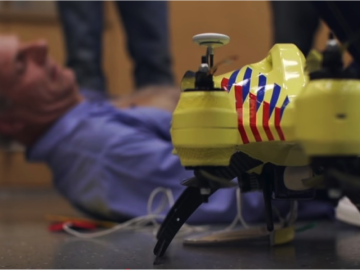The applications of 6G: what will it change?

Looking ahead to 2030 and beyond, the improvement of the network and capabilities of XR terminals will push XR technology into an era of full immersion. XR or ‘extended reality’ is an umbrella term for virtual reality (VR), augmented reality (AR) and mixed reality (MR). What real life applications can we expect, roughly in a decade from now?
Looking ahead to 2030 and beyond, the improvement of the network and capabilities of XR terminals will push XR technology into an era of full immersion. XR or ‘extended reality’ is an umbrella term for virtual reality (VR), augmented reality (AR) and mixed reality (MR). What real life applications can we expect, roughly in a decade from now?
Most prominently, XR technology in the cloud will reduce the computing load and energy consumption significantly. The XR system in the cloud will be combined with next-generation networking, Quantum computing, cloud computing, big data, artificial intelligence and other technologies. Thus enabling the radical digital transformation of various industries, culture and entertainment, education and training, medical and healthcare, and much more.
Beam me up, Scotty
The immersive experience implies holographic communication and sensory interconnection that will facilitate the three-dimensional dynamic interaction. People, things and their surrounding can be communicated through a natural and realistic visual representation, not limited by time and space, and including senses smell, taste and touch.
Concretely? Think of technicians remotely performing repairs, doctors performing operations remotely, and enhanced remote teaching in classrooms. Millisecond-level delay will provide users with a better connection experience. In terms of security, sensory interconnection with multiple senses interacting, can also be more robust in order to protect the privacy of users.
The ultimate user experience
6G networks and wireless communication systems will be able to use sensor functions to obtain information about the environment, allocate communication resources intelligently and accurately, tap into communication opportunities and improve user experience.
Digital twin of the physical world
By mining rich historical and real-time data in the digital world and using advanced algorithm models to generate perception and cognitive intelligence, the digital world simulate, verify, predict and control physical entities or processes to obtain the optimal state of the physical world.
Concretely? The medical system can use information from its digital twin the human body to make a disease diagnosis and predict the best treatment plan. In the industrial or agricultural field, product design can be optimised to reduce costs and increase efficiency, simulate production processes, and so on. This comes close to autonomizing processes such as planning or self-repair.
Global coverage
With the gradual integration of services and the continuous expansion of deployment scenarios, the ground-based cellular network and space network, including satellite networks and high-altitude platforms and drones will be integrated with each other, creating global coverage.
Concretely? Broadband access services for remote areas, aircraft, drone cars, ships, etc. Ultra-high precision navigation providing information and monitoring of crops, rare animals, sea buoys, sea container, emergency rescue and traffic dispatch.
AI getting smarter
We can conclude that more and more personal and home appliances, urban sensors, unmanned vehicles, smart robots, etc., will become new types of smart terminals. These trillions of interconnected smart devices can not only support data transmission at high speed, but also provide ultra-efficient simulation and prediction of how the physical world functions and evolves.
Image, voice, temperature and other data can be used for smart learning and collaboration. AI will connect to local data, to achieve reliable and low latency communication and collaboration between different smart terminals. And as AI will continue to learn through big data, work efficiency and accuracy will continue to improve.
Therefore, we are also incredibly grateful that Proximus is one of our partners. They are a leader in the Belgian market in terms of connectivity and quantum security. We look forward to what the future holds in store for us...
Latest insights & stories

A Global Movement: The World Unites in a Pink Pledge for Clean and Sustainable Water
5,000 participants. 32 countries. €30,000 funds raised. And that's just the beginning.
Picture this: One step that sends ripples across the globe, transforming lives and creating waves of change. You might wonder, how can such a simple action for most of us have such a profound impact?

Sustainability and circularity in construction
Join us in transforming the future of construction, creating buildings that not only stand the test of time but also contribute to a healthier planet!

RainTunes: Shower scenarios for the soul
Light, hearing, smell, and touch: Together with experts, we have developed sensuous scenarios that turn showering into an individual experience. Whether you want to prepare for the day ahead or relax after working out. Whether you want to refresh after a day’s work or unwind at the end of the evening: RainTunes surprises with multisensory experiences.*
*Currently available only in Germany and Austria.